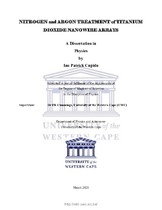Nitrogen and argon treatment of titanium dioxide nanowire arrays
Abstract
TiO2 nanoparticle films are important electron transport layers (ETLs) in photovoltaics such as
dye-sensitised, perovskite and polymer hetero-junction solar cells. These films, however, have
significant electron trap-sites as a result of the large density of oxygen vacancies present in nanosized
TiO2. These trap-sites cause electron-hole recombination and ultimately lower photon-tocurrent
conversion efficiency of the underlying cell during operation. Doping the TiO2 lattice with
low atomic number elements such as nitrogen is a proven method to overcoming the charge
transport inefficiency of TiO2 ETLs; another is the use of one-dimensional (1D) nanowires (NWs),
instead of nanoparticles.
Modification of TiO2 with non-metals leads to optical bandgap narrowing, improvement in
electron conductivity and increased electron lifetime in the ETL layer. However, a lot of scope
exists in understanding and fully quantifying the relationship between optical property, for
example light transmission and bandgap modification, versus the doping concentration and type.
Most doping approaches are in-situ and involve the addition of a dopant precursor (usually a salt)
during the synthesis of TiO2 nanostructures – this invariably leads to uncontrolled doping levels,
anion contamination and poor-quality materials – a need thus exists to develop simple, controllable
doping approaches. One such approach, which forms the basis of this study, is ex-situ doping by
means of plasma generated species in a controlled environment. This field of study is fairly novel
and not widely studied, requiring more research to understand the doping mechanisms and
influence on the optical and electronic properties of the underlying nanomaterials. In particular,
controlled doping of TiO2 with nitrogen using radio-frequency generated (RF) plasma requires
vigorous experimentation and characterisation. Inaccuracy of the deposition parameters during
exposure remains a common drawback for this approach in addition to a lack of understanding of
the surface interaction between the N2 species and specimen during irradiation.

